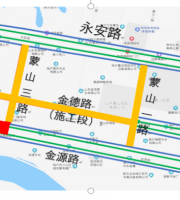2.4.4 inspect and order prefabricated parts manufacturers and cast iron parts manufacturers.
Different types of cement shall not be mixed.
The concrete thickness is generally 100mm.
After entering the site, samples shall be sent to pass the retest.
3.2.3.3 during concrete pouring, the concrete shall be vibrated and compacted manually, and the surface shall be roughened with a wooden trowel.
It shall be used up within 2.5h after mixing (when the temperature exceeds 300C, it shall be used up within 1.5h).
2.4.3 draw the layout plan and detailed drawing of brick laying bottom of rainwater inlet.
The wall fertilizer tank shall be backfilled and compacted in time for every 300mm high.
If the branch pipes must be skewed according to the design requirements, the pipe orifice is allowed to enter the wall for 20mm and the other side protrudes for 20mm, and the pipe end face shall be complete without damage.
3.2.4.11 the mortar between the rainwater branch pipe and the well wall shall be full, the pipe top shall be issued with 125mm brick coupons, and the pipe orifice shall be flush with the well wall.
2.1.6 lintel and concrete well ring: finished products or prefabricated on site.
3.2.3 concrete foundation 3.2.3.1 before pouring foundation concrete, the groove bottom shall be carefully compacted, and the water shall be removed.
Check the diagonal size and squareness according to the length and width.
2.1.2 cement: Ordinary portland cement and slag Portland cement with strength grade of 32.5 are generally used.
The mud content of the sand shall not exceed 3%, and its quality shall meet the requirements of the current national standard quality standard and inspection method of sand for ordinary concrete jgj52.
Scope of application this standard is applicable to inlets of urban road drainage works.
3.2.4.2 select bricks with appropriate quantity and qualified quality and transport them to the masonry site.
3.
See Fig.
If this limit is exceeded, the position of the rainwater inlet shall be adjusted..
During excavation, check the position of the rainwater inlet.
The mortar joint width shall be controlled within 8 ~ 12mm.
In case of error, the branch pipe shall prevail, parallel to the roadside, correct the position, and excavate to the design depth.
Construction process standard for inlets 1.
First build a layer of the well wall.
3.2.4.6 measure the inner and outer lines and corner piles of the rainwater inlet wall, and build the wall accordingly.
The foundation size and concrete grade shall be determined according to the design requirements and standard atlas.
Construction preparation 2.1 materials 2.1.1 brick for masonry: variety, specification, appearance, strength and quality shall comply with the provisions of the current national standard sintered ordinary brick GB / t5101, And meet the design requirements.
3.2.4.7-23.2.4.8 for the well size and brick arrangement.
2.3 operating conditions when the inlet is located on the new road, the construction of pavement base has been completed.
3.2.4.7-1 and Fig.
3.2.4.7 hang the line according to the position of the well wall.
3.2.4.4 mortar mixing: mechanical mixing shall be adopted, the mixing time shall not be less than 90s, and the consistency shall be controlled at 50 ~ 70mm.
The excavation sideline shall be determined according to the structural size of the rainwater inlet, and 300 ~ 500mm shall be reserved on each side.
2.1.4 sand: medium coarse sand with hard texture, good grading and clean shall be used.
2.4.5 do a good job in the construction mix proportion of on-site mixing mortar, and prepare mortar and concrete trial formwork.
2.1.3 water: drinking water should be used.
2.2.2 tools: level, small line, tile knife, shovel, line drop, trolley, sieve, ash trough, bucket, etc.
The cement shall be provided with product certificate and delivery inspection report.
3.2.4.3 cement mortar shall be mixed on site according to the cement mortar mix proportion provided by the laboratory.
After pouring, the method of covering and watering should be adopted for curing.
3.2.2 trench excavation: when the rainwater inlet trench is excavated manually, it must be excavated in strict accordance with the excavation sideline.
Click the blue word to get more wonderful information.
3.2.3.2 concrete with grade no less than C10 is generally used.
If the mortar has bleeding, it shall be remixed before masonry.
3.2.4.10 for brick wall masonry, bricks shall be staggered up and down and overlapped with each other.
2.4 technical preparation 2.4.1 prepare construction scheme and conduct technical disclosure to operators.
The bricks shall be watered and wetted the day before the well wall is built (except in winter).
Inlets of other drainage works can refer to 2.
Generally, bricks for masonry shall have a strength of not less than mu10, and must have factory product quality certificate and test report.
3.2.4.9 when building the well wall, the mortar joint shall be full, and plastering shall be carried out at the same time.
Operation process 3.1 process flow 3.2 operation method 3.2.1 measurement and setting out: according to the design drawings, determine the position of the rainwater inlet according to the design sideline of the road and the position of the branch pipe, determine the centerline pile of the rainwater outlet, make the long side of the rainwater inlet coincide with the road sideline (except the curve part), and set out the excavation sideline of the rainwater outlet.
2.4.2 count the quantity of materials and prepare the material plan according to the design drawings.
After entering the site, the strength, stability and other necessary performance indexes shall be sampled and retested, and the quality must comply with the current national table niece Portland cement, ordinary portland cement GB175, etc.
2.1.5 cast iron grate and cast iron well ring: meet the requirements of standard atlas and have factory product quality certificate.
After entering the site, samples shall be taken and retested to be qualified.
When other water sources are used, the water quality shall comply with the current national standard water standard for concrete mixing jgj63.
3.2.4 well wall masonry and plastering 3.2.4.1 the masonry of the inlet can be carried out only after the strength of the concrete foundation of the inlet reaches 5MPa.
2.2 machines and tools 2.2.1 machines and tools: mortar mixer, metering equipment, etc.
When there is doubt about the quality of cement or the cement has been delivered for more than three months, it must be retested before reuse and used according to the retest results.
When the groove bottom is soft, the 3:7 lime soil foundation can be compacted.
3.2.4.5 mortar shall be mixed and used at the same time.
The backfill material shall be lime fly ash mixture or low-grade concrete.
The finished components shall be provided with factory certificate, and the quality of raw materials for on-site precast lintel and concrete well ring shall meet the provisions of relevant standards and design requirements.


